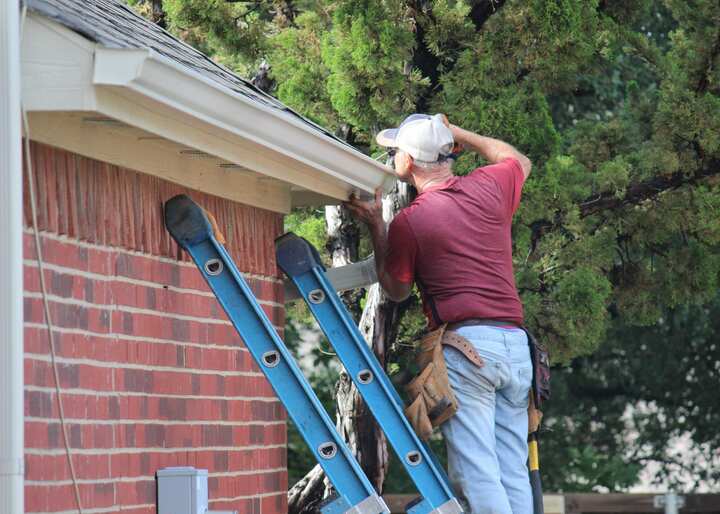
What are the most common types of emergency roof repairs?
Roof repairs are an essential aspect of any home maintenance routine. A well-maintained roof not only protects the structural integrity of a building but also keeps its inhabitants safe and comfortable. However, sometimes emergencies arise, and homeowners find themselves in need of immediate repair services. Emergency roof repairs can be caused by various factors, including natural disasters such as windstorms or hailstorms, falling tree branches, or even wear and tear due to age.
Fixing a leak
Addressing a leak in the roofing system typically involves identifying the source of moisture intrusion, which may require an assessment of various components such as flashing, shingles, or sealants. Once the source has been identified, fixing the leak can involve a range of repairs depending on the severity and location of the issue. For instance, if the leak is caused by damaged shingles or tiles, replacing them may be necessary to prevent further water penetration.
In some cases, repairing a leaky roof may also require addressing underlying structural issues that have created vulnerabilities in the roofing system. This could include reinforcing weakened areas or replacing damaged rafters that are contributing to sagging or warping in the roof structure. Overall, fixing a leak requires careful attention to detail and expertise in diagnosing and addressing both visible symptoms and underlying causes of moisture intrusion.
Repairing wind damage
Wind damage is a frequent cause of roof repair. Strong winds can cause shingles to become dislodged or damaged, leaving the underlying structure exposed to the elements. The most common sign of wind damage is missing or cracked shingles, but other signs may include curled or buckled shingles, loose flashing, and even small holes in the roof.
When repairing wind damage on a roof, it's important to address not only the visible damage but also any underlying issues that may have contributed to the problem. This may involve reinforcing weak spots in the roofing structure or installing additional support for areas that are particularly vulnerable to high winds.
In some cases, it may be necessary to replace entire sections of the roof in order to ensure that it is properly protected against future wind damage. Overall, taking prompt action when wind damage occurs can help prevent further problems and extend the lifespan of your home's roofing system.
Addressing tree damage
Tree branches falling onto roofs can cause significant damage and compromise the structural integrity of a building's roofing system. When such damage occurs, it is vital to address it promptly to prevent further issues. The first step in addressing tree damage is to assess the extent of the damage and determine whether any underlying structural issues have been compromised. In some cases, a simple repair may suffice, while in others, more extensive work may be necessary.
Once the extent of the damage has been assessed, repairs can begin. This typically involves removing any debris and repairing any damaged roofing materials. If there are any underlying structural issues that have been compromised as a result of the tree damage, additional work may be required before repairs can begin on the roof itself.
It is important to hire a professional contractor who has experience with emergency roof repairs to ensure that all necessary work is completed safely and effectively. By taking prompt action and working with an experienced contractor, homeowners can minimize their risk of further problems and ensure that their roofing system remains strong and secure for years to come.
Dealing with hail damage
Hail damage can cause significant harm to a building's roofing system, leading to the need for prompt repairs to prevent further issues. Hailstones can range in size from small pellets to large chunks, and depending on their size and velocity, they can puncture or crack roof shingles, dislodge granules from asphalt shingles, or dent metal roofs.
The most common signs of hail damage include dents or cracks on the surface of the roof, missing or broken shingles, granule loss on asphalt shingles, and leaks in the attic or ceiling.
To deal with hail damage, homeowners should inspect their roof after every major storm event and look for any visible signs of damage. If there are only a few damaged shingles or tiles, they can be replaced individually without replacing the entire roof. However, if there is widespread hail damage that affects more than 30% of the roof surface area, it may be necessary to replace the entire roof.
Fixing ice damming issues
Ice damming on roofs during winter can cause significant damage and requires immediate attention to prevent further issues. This occurs when snow or ice accumulates on the roof, melts due to heat loss from the building, and then refreezes at the edge of the roof. The resulting ice dam prevents water from draining off the roof properly, causing it to back up under shingles and into the attic or interior walls.
To fix ice damming issues, there are several steps that homeowners can take. The first step is to remove any snow build-up from the roof using a rake or shovel. If you're not comfortable doing this yourself, it's best to hire a professional roofer who has experience in dealing with these types of situations.
Another solution is to install heated cables along the edge of your roofline which will melt any accumulated snow or ice before it has a chance to form an ice dam. Finally, improving insulation and ventilation in your home can help reduce heat loss through your roof and minimize future occurrences of ice damming. If you're looking for emergency roof repair contractors that can restore or replace your roof with professional service and quality materials, we've got your covered. Get in touch with our experts today.